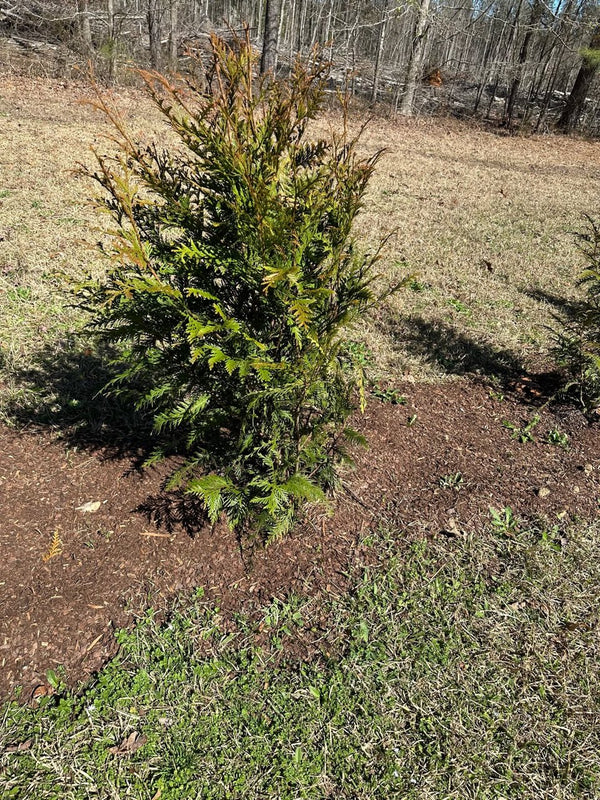I. Introduction
Welcome to our guide on creating a living fence with Thuja Green Giants! If you're looking to add privacy, beauty, and functionality to your outdoor space, Thuja Green Giants are an excellent choice. In this blog post, we will walk you through the process of creating a living fence or privacy screen using these impressive trees.
II. Understanding Thuja Green Giants
Before we delve into the details of creating a living fence, let's take a moment to understand why Thuja Green Giants are ideal for this purpose. These trees, scientifically known as Thuja standishii x plicata 'Green Giant,' are a hybrid of two Thuja species. They are known for their fast growth, typically reaching heights of 3 to 5 feet per year and ultimately reaching 30 to 60 feet tall. Their lush foliage consists of vibrant, dense, deep green leaves that maintain their color throughout the year, providing year-round privacy and beauty to your landscape.
Thuja Green Giants are particularly suitable for living fences due to their dense growth habit and columnar shape. They naturally grow in a narrow, pyramidal form, making them an excellent choice for creating a screen or fence along property boundaries. The dense foliage of these trees effectively blocks out unwanted views, reduces noise, and provides a sense of seclusion.
III. Choosing the Right Location for Your Living Fence
Before you start planting Thuja Green Giants, it's important to carefully choose the right location for your living fence. Here are some factors to consider:
a) Sunlight Requirements: Thuja Green Giants thrive in full sun to partial shade. Ensure that the area you select receives at least six hours of direct sunlight per day. Insufficient sunlight can result in slower growth and less dense foliage.
b) Soil Type: Thuja Green Giants can adapt to various soil types, but they prefer well-draining soil with a slightly acidic to neutral pH level. Conduct a soil test to assess its pH and make any necessary amendments to create an optimal growing environment for your trees.
c) Space Needed: Consider the space required for your living fence. Thuja Green Giants should be spaced about 6 to 8 feet apart for optimal privacy and density. Measure the area and plan accordingly, keeping in mind the mature size of the trees.
Taking the time to choose the right location will ensure the success and longevity of your Thuja Green Giant living fence. With these factors in mind, let's move on to the next section: planting Thuja Green Giants!
IV. Planting Thuja Green Giants
Now that you have chosen the right location for your living fence, it's time to start planting Thuja Green Giants. Follow these steps to ensure a successful planting process:
a) Timing: The best time to plant Thuja Green Giants is during the early spring or fall. This allows the trees to establish their root systems before the extreme temperatures of summer or winter.
b) Digging the Holes: Dig individual holes for each tree, making them slightly wider and deeper than the root ball. Ensure that the holes are spaced according to your desired spacing for the living fence.
c) Preparing the Soil: Loosen the soil at the bottom of the holes and remove any weeds or rocks. You can also incorporate organic matter, such as compost, to improve soil fertility and drainage.
d) Planting the Trees: Carefully remove the Thuja Green Giants from their containers and gently loosen the root ball. Place each tree in its respective hole, ensuring that the top of the root ball is level with or slightly above the ground surface. Backfill the hole with soil, gently firming it around the roots to eliminate air pockets.
e) Watering: Give the newly planted trees a thorough watering immediately after planting to settle the soil and help establish root growth. Provide regular watering throughout the first growing season, keeping the soil moist but not waterlogged.
f) Mulching: Apply a layer of organic mulch around the base of each tree, leaving a gap around the trunk to prevent moisture buildup and potential rot. Mulch helps retain soil moisture, suppresses weed growth, and regulates soil temperature.
As Thuja Green Giants establish and grow, their dense foliage will contribute to the privacy and beauty of your living fence. In the next section, we will discuss how to care for your Thuja Green Giants to ensure their health and longevity.
Note: It's important to refer to specific planting instructions provided by your nursery or consult with a local gardening expert to tailor the planting process to your specific region and climate.
V. Caring for Your Thuja Green Giants
Proper care is essential to maintain the health and vitality of your Thuja Green Giants and ensure their effectiveness as a living fence. Here are some important aspects of caring for your trees:
a) Watering: Thuja Green Giants have moderate water needs. After the initial watering following planting, continue to provide regular watering during dry periods, especially in the first year. Aim for deep, thorough watering to encourage deep root growth. Avoid overwatering, as it can lead to root rot and other issues.
b) Fertilizing: Thuja Green Giants generally do well without excessive fertilization. However, applying a slow-release, balanced fertilizer in early spring can provide additional nutrients for healthy growth. Follow the manufacturer's instructions for proper application rates.
c) Pruning: Regular pruning is not usually necessary for Thuja Green Giants used as a living fence. However, you may selectively prune to shape the trees or remove any damaged or diseased branches. If pruning is desired, do so during the dormant season to minimize stress on the trees.
d) Monitoring for Pests and Diseases: Thuja Green Giants are generally resistant to pests and diseases. However, it's still important to monitor the trees regularly for any signs of pest infestation or diseases such as fungal infections. Treat any issues promptly to prevent their spread.
e) Seasonal Considerations: Thuja Green Giants are evergreen trees, meaning they retain their foliage throughout the year. However, it's natural for some browning or shedding of older foliage to occur. This is usually a cosmetic issue and doesn't indicate a problem with the tree's health.
f) Regular Inspections: Regularly inspect your Thuja Green Giants for any signs of stress, damage, or abnormal growth. Look for discoloration, wilting, or unusual patterns in the foliage. Early detection can help address any issues before they escalate.
By providing adequate water, occasional fertilization, and monitoring the health of your Thuja Green Giants, you can maintain a thriving and beautiful living fence for years to come. In the next section, we will discuss additional maintenance and troubleshooting tips to ensure the longevity of your living fence.
Note: Specific care requirements may vary depending on your location, climate, and individual tree health. Always refer to local gardening guidelines and consult with professionals for personalized advice.
VI. Maintenance and Troubleshooting
Maintaining your Thuja Green Giant living fence involves a few additional steps to ensure its health and longevity. Here are some maintenance and troubleshooting tips to consider:
a) Regular Inspections: Conduct periodic inspections of your living fence to check for any signs of stress, disease, or insect infestation. Look for discoloration, leaf spots, wilting, or abnormal growth patterns. Promptly address any issues that arise.
b) Weed Control: Keep the area around your Thuja Green Giants free from weeds and competing vegetation. Weeds can steal nutrients and water from the trees, hindering their growth. Apply mulch and use appropriate weed control methods to minimize weed growth.
c) Wind Protection: If your location is prone to strong winds, consider providing wind protection for your living fence. Erecting a windbreak or installing temporary windbreak fabric during extreme weather can help protect the trees from wind damage.
d) Winter Protection: In regions with harsh winters, young Thuja Green Giants may benefit from some winter protection. Consider wrapping the trunks with burlap or using anti-desiccant sprays to prevent winter burn caused by cold winds and low temperatures.
e) Disease and Pest Management: Although Thuja Green Giants are generally resistant to many diseases and pests, occasional issues may arise. Familiarize yourself with common diseases and pests that can affect these trees in your area. If necessary, consult with a local arborist or horticulturist for appropriate prevention or treatment methods.
VII. The Benefits of a Thuja Green Giant Living Fence
Creating a living fence with Thuja Green Giants offers numerous benefits beyond privacy. Here are some advantages to highlight:
a) Privacy and Security: Thuja Green Giants provide a dense, year-round barrier that offers privacy and security, shielding your property from prying eyes.
b) Noise Reduction: The thick foliage of Thuja Green Giants helps absorb and reduce noise, making them an effective natural sound barrier.
c) Wind and Snow Protection: A living fence created with Thuja Green Giants can act as a windbreak, minimizing the impact of strong winds. The trees also capture blowing snow, helping to reduce snowdrifts.
d) Aesthetic Appeal: Thuja Green Giants are visually appealing, adding beauty and texture to your landscape. Their vibrant, evergreen foliage creates an attractive backdrop for other plants and garden features.
e) Wildlife Habitat: The dense foliage of Thuja Green Giants provides shelter and nesting opportunities for birds and other small wildlife, contributing to biodiversity and creating a vibrant ecosystem in your yard.
By highlighting these benefits, you can emphasize the value and versatility of a living fence created with Thuja Green Giants.
VIII. Conclusion
Creating a living fence with Thuja Green Giants is an excellent choice for homeowners seeking privacy, beauty, and functionality. By carefully selecting the location, following proper planting techniques, and providing necessary care, you can enjoy the benefits of a thriving and attractive living fence for years to come.
IX. Conclusion
If you're ready to create your own living fence, start by selecting the Thuja Green Giants that suit your needs. Plan your planting strategy, gather the necessary materials, and embark on this rewarding landscaping project. Share your experiences, questions, or success stories in the comments section below. And for further reading, explore our other articles on landscaping and tree care.
Create a stunning living fence with Thuja Green Giants and transform your outdoor space into a private oasis of natural beauty and tranquility.

